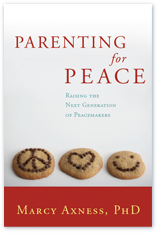As we reach hump day of Empowered Birth Awareness Week, how fitting that Step 4 of my Parenting for Peace roadmap is actually entitled “Empowered Birth”! The book is based on 7 principles, applied through 7 steps in time — beginning pre-conception and going through adolescence. In honor of EBAW, here is a collection (in 2 parts) of practical ideas of how to engage each of the 7 Parenting for Peace principles in specific ways to up your odds of having an empowered birth.
Principles for Empowered Birth: Part I
 Presence – I can think of few more potent opportunities to discover and practice advanced dimensions of this principle than during labor and birth. Birth anthropologist Robbie Davis-Floyd, in describing how she charted a new rapport with presence during her second labor (a home VBAC), compares it to swimming a marathon, noting that the champions “don’t count the distance. They enter a timeless dimension, where this stroke is all there is. This stroke, and this one, and then this one. I am in that timeless world. I quit wondering eons ago when the baby will come out. There is only this contraction, and this push, and this pause, and then this contraction, and this push, and—Then the midwife’s Voice, summoning forth my consciousness from its burial in the depths of sensation.” {Read the rest at mothering.com}
Presence – I can think of few more potent opportunities to discover and practice advanced dimensions of this principle than during labor and birth. Birth anthropologist Robbie Davis-Floyd, in describing how she charted a new rapport with presence during her second labor (a home VBAC), compares it to swimming a marathon, noting that the champions “don’t count the distance. They enter a timeless dimension, where this stroke is all there is. This stroke, and this one, and then this one. I am in that timeless world. I quit wondering eons ago when the baby will come out. There is only this contraction, and this push, and this pause, and then this contraction, and this push, and—Then the midwife’s Voice, summoning forth my consciousness from its burial in the depths of sensation.” {Read the rest at mothering.com}
Image:
Jason Lander through a Creative Commons license
 I cannot let
I cannot let 
 Presence – I can think of few more potent opportunities to discover and practice advanced dimensions of this principle than during labor and birth. Birth anthropologist Robbie Davis-Floyd, in describing how she charted a new rapport with presence during her second labor (a home VBAC), compares it to swimming a marathon, noting that the champions “don’t count the distance. They enter a timeless dimension, where this stroke is all there is. This stroke, and this one, and then this one. I am in that timeless world. I quit wondering eons ago when the baby will come out. There is only this contraction, and this push, and this pause, and then this contraction, and this push, and—Then the midwife’s Voice, summoning forth my consciousness from its burial in the depths of sensation.”
Presence – I can think of few more potent opportunities to discover and practice advanced dimensions of this principle than during labor and birth. Birth anthropologist Robbie Davis-Floyd, in describing how she charted a new rapport with presence during her second labor (a home VBAC), compares it to swimming a marathon, noting that the champions “don’t count the distance. They enter a timeless dimension, where this stroke is all there is. This stroke, and this one, and then this one. I am in that timeless world. I quit wondering eons ago when the baby will come out. There is only this contraction, and this push, and this pause, and then this contraction, and this push, and—Then the midwife’s Voice, summoning forth my consciousness from its burial in the depths of sensation.” 

